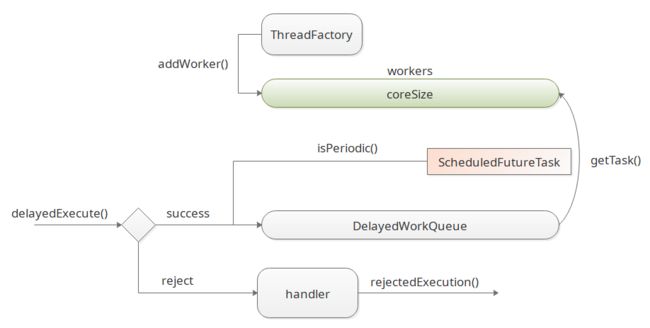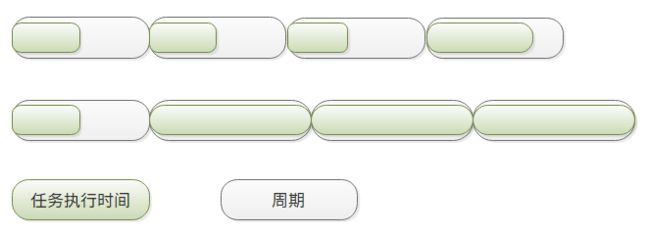文本将主要讲述 ThreadPoolExecutor 一个特殊的子类 ScheduledThreadPoolExecutor,主要用于执行周期性任务;所以在看本文之前最好先了解一下 ThreadPoolExecutor ,可以参考 ThreadPoolExecutor 详解;另外 ScheduledThreadPoolExecutor 中使用了延迟队列,主要是基于完全二叉堆实现的,可以参考 完全二叉堆;
一、ScheduledThreadPoolExecutor 结构概述
1. 继承关系
public class ScheduledThreadPoolExecutor
extends ThreadPoolExecutor implements ScheduledExecutorService {}在源码中可以看到,ScheduledThreadPoolExecutor 的状态管理、入队操作、拒绝操作等都是继承于 ThreadPoolExecutor;ScheduledThreadPoolExecutor 主要是提供了周期任务和延迟任务相关的操作;
- schedule(Runnable command, long delay, TimeUnit unit) // 无返回值的延迟任务
- schedule(Callable callable, long delay, TimeUnit unit) // 有返回值的延迟任务
- scheduleAtFixedRate(Runnable command, long initialDelay, long period, TimeUnit unit) // 固定频率周期任务
- scheduleWithFixedDelay(Runnable command, long initialDelay, long delay, TimeUnit unit) // 固定延迟周期任务
就 ScheduledThreadPoolExecutor 的运行逻辑而言,大致可以表述为:
- 首先将 Runnable/Callable 封装为 ScheduledFutureTask,延迟时间作为比较属性;
- 然后加入 DelayedWorkQueue 队列中,每次取出队首延迟最小的任务,超时等待,然后执行;
- 最后判断是否为周期任务,然后将其重新加入 DelayedWorkQueue 队列中;
其内部结构如图所示:
这里需要注意的:
- ScheduledThreadPoolExecutor 中的队列不能指定,只能是 DelayedWorkQueue;因为他是 无界队列,所以再添加任务的时候线程最多可以增加到 coreSize,这里不清楚的可以查看 ThreadPoolExecutor 详解 ,就不再重复了;
- ScheduledThreadPoolExecutor 重写了 ThreadPoolExecutor 的 execute() 方法,其执行的核心方法变成 delayedExecute();
2. ScheduledFutureTask
private class ScheduledFutureTask extends FutureTask implements RunnableScheduledFuture {
private final long sequenceNumber; // 任务序号,从 AtomicLong sequencer 获取,当延迟时间相同时,序号小的先出
private long time; // 下次任务执行时间
private final long period; // 0 表示非周期任务,正值表示固定频率周期任务,负值表示固定延迟周期任务
RunnableScheduledFuture outerTask = this; // 重复执行的任务,传入的任务可以使用 decorateTask() 重新包装
int heapIndex; // 队列索引
} 其中最重要的方法必然是 run 方法了:
public void run() {
boolean periodic = isPeriodic(); // 是否为周期任务,period != 0
if (!canRunInCurrentRunState(periodic)) // 当前状态能否继续运行,详细测试后面还会讲到
cancel(false); // 取消任务
else if (!periodic) // 不是周期任务时,直接运行
ScheduledFutureTask.super.run();
else if (ScheduledFutureTask.super.runAndReset()) { // 时周期任务
setNextRunTime(); // 设置下次执行时间
reExecutePeriodic(outerTask); // 重新入队
}
}public boolean cancel(boolean mayInterruptIfRunning) {
boolean cancelled = super.cancel(mayInterruptIfRunning); // 设置中断状态
if (cancelled && removeOnCancel && heapIndex >= 0) // 当设置 removeOnCancel 状态时,移除任务
remove(this); // 默认为 false
return cancelled;
}void reExecutePeriodic(RunnableScheduledFuture task) {
if (canRunInCurrentRunState(true)) { // 如果当前状态可以执行
super.getQueue().add(task); // 则重新入队
if (!canRunInCurrentRunState(true) && remove(task))
task.cancel(false);
else ensurePrestart(); // 确保有线程执行任务
}
}此外还有 DelayedWorkQueue,但是这里不准备讲了,可以查看 完全二叉堆 了解实现的原理;
二、scheduleAtFixedRate 与 scheduleWithFixedDelay
scheduleAtFixedRate 和 scheduleWithFixedDelay 是我们最常用的两个方法,但是他们的区别可能不是很清楚,这里重点讲一下,
1. scheduleAtFixedRate
// 测试
ScheduledThreadPoolExecutor pool = new ScheduledThreadPoolExecutor(1);
pool.scheduleAtFixedRate(() -> {
sleep(1000); // 睡眠 1s,
log.info("run task");
}, 1, 2, TimeUnit.SECONDS); // 延迟 1s,周期 2s// 打印
[19:41:28,489 INFO ] [pool-1-thread-1] - run task
[19:41:30,482 INFO ] [pool-1-thread-1] - run task
[19:41:32,483 INFO ] [pool-1-thread-1] - run task
[19:41:34,480 INFO ] [pool-1-thread-1] - run task
可以看到的确时固定周期 2s 执行的,但是如果任务执行时间超过周期呢?
// 测试
ScheduledThreadPoolExecutor pool = new ScheduledThreadPoolExecutor(1);
pool.scheduleAtFixedRate(() -> {
int i = 2000 + random.nextInt(3) * 1000;
sleep(i);
log.info("run task, sleep :{}", i);
}, 1, 2, TimeUnit.SECONDS); // 延迟 1s,周期 2s// 打印
[19:42:53,428 INFO ] [pool-1-thread-1] - run task, sleep :2000
[19:42:55,430 INFO ] [pool-1-thread-1] - run task, sleep :2000
[19:42:59,430 INFO ] [pool-1-thread-1] - run task, sleep :4000
[19:43:02,434 INFO ] [pool-1-thread-1] - run task, sleep :3000
[19:43:06,436 INFO ] [pool-1-thread-1] - run task, sleep :4000
可以看到如果任务执行时间超出周期时,下一次任务会立刻运行;就好像周期是一个有弹性的袋子,能装下运行时间的时候,是固定大小,装不下的时候就会被撑大,图像化表示如下:
2. scheduleWithFixedDelay
// 测试
ScheduledThreadPoolExecutor pool = new ScheduledThreadPoolExecutor(1);
pool.scheduleAtFixedRate(() -> {
int i = 1000 + random.nextInt(5) * 1000;
sleep(i);
log.info("run task, sleep :{}", i);
}, 1, 2, TimeUnit.SECONDS); // 延迟 1s,周期 2s// 打印
[20:05:40,682 INFO ] [pool-1-thread-1] - run task, sleep :1000
[20:05:45,686 INFO ] [pool-1-thread-1] - run task, sleep :3000
[20:05:49,689 INFO ] [pool-1-thread-1] - run task, sleep :2000
[20:05:55,690 INFO ] [pool-1-thread-1] - run task, sleep :4000
[20:06:01,692 INFO ] [pool-1-thread-1] - run task, sleep :4000
可以看到无论执行时间是多少,其结果都是在执行完毕后,停顿固定的时间,然后执行下一次任务,其图形化表示为:
三、 源码分析
1. 延迟任务
public void execute(Runnable command) {
schedule(command, 0, NANOSECONDS);
}
public Future submit(Callable task) {
return schedule(task, 0, NANOSECONDS);
}
public ScheduledFuture schedule(Runnable command, long delay, TimeUnit unit) {
if (command == null || unit == null) throw new NullPointerException();
RunnableScheduledFuture t = decorateTask(
command,new ScheduledFutureTask(command, null, triggerTime(delay, unit)));
delayedExecute(t);
return t;
}
public ScheduledFuture schedule(Callable callable, long delay, TimeUnit unit) {
if (callable == null || unit == null) throw new NullPointerException();
RunnableScheduledFuture t = decorateTask(
callable, new ScheduledFutureTask(callable, triggerTime(delay, unit)));
delayedExecute(t);
return t;
} 可以看到所有的周期任务,最终执行的都是 delayedExecute 方法,其中 decorateTask 是一个钩子函数,其之类可以利用他对任务进行重构过滤等操作;
private void delayedExecute(RunnableScheduledFuture task) {
if (isShutdown()) reject(task); // 如果线程池已经关闭,则拒绝任务
else {
super.getQueue().add(task); // 任务入队
if (isShutdown() && // 再次检查,线程池是否关闭
!canRunInCurrentRunState(task.isPeriodic()) &&
remove(task))
task.cancel(false);
else
ensurePrestart(); // 确保有线程执行任务
}
}2. 周期任务
public ScheduledFuture scheduleAtFixedRate(Runnable command, long initialDelay,
long period, TimeUnit unit) {
if (command == null || unit == null) throw new NullPointerException();
if (period <= 0) throw new IllegalArgumentException();
ScheduledFutureTask sft =
new ScheduledFutureTask(command,
null,
triggerTime(initialDelay, unit),
unit.toNanos(period)); // 注意这里添加的是正值
RunnableScheduledFuture t = decorateTask(command, sft);
sft.outerTask = t;
delayedExecute(t);
return t;
}
public ScheduledFuture scheduleWithFixedDelay(Runnable command, long initialDelay,
long delay, TimeUnit unit) {
if (command == null || unit == null) throw new NullPointerException();
if (delay <= 0) throw new IllegalArgumentException();
ScheduledFutureTask sft =
new ScheduledFutureTask(command,
null,
triggerTime(initialDelay, unit),
unit.toNanos(-delay)); // 注意这里添加的是负值
RunnableScheduledFuture t = decorateTask(command, sft);
sft.outerTask = t;
delayedExecute(t);
return t;
} 从上面代码可以看到 scheduleAtFixedRate 和 scheduleWithFixedDelay 只有周期任务的时间不同,其他的都一样,那么下面我们看一下他们的任务时间计算;
public long getDelay(TimeUnit unit) {
return unit.convert(time - now(), NANOSECONDS);
}
private void setNextRunTime() {
long p = period;
if (p > 0) // 正值表示 scheduleAtFixedRate
time += p; // 不管任务执行时间,直接加上周期时间,也就是一次任务超时,会影响后续任务的执行,
// 超时的时候,getDelay 是负值,所以在延迟队列中必然排在最前面,立刻被取出执行
else
time = triggerTime(-p); // 计算触发时间
}
long triggerTime(long delay) { // 这里可以看到,每次的确是在当前时间的基础上,加上延迟时间;
return now() + ((delay < (Long.MAX_VALUE >> 1)) ? delay : overflowFree(delay));
}这里特别要注意 scheduleAtFixedRate 一次任务超时,会持续影响后面的任务周期安排,所以在设定周期的时候要特别注意; 例如:
// 测试
ScheduledThreadPoolExecutor pool = new ScheduledThreadPoolExecutor(1);
pool.scheduleAtFixedRate(() -> {
int i = random.nextInt(5) * 1000;
sleep(i);
log.info("run task, sleep :{}", i);
}, 1, 2, TimeUnit.SECONDS);// 打印
[20:29:11,310 INFO ] [pool-1-thread-1] - run task, sleep :1000
[20:29:16,304 INFO ] [pool-1-thread-1] - run task, sleep :4000
[20:29:19,304 INFO ] [pool-1-thread-1] - run task, sleep :3000
[20:29:21,305 INFO ] [pool-1-thread-1] - run task, sleep :2000
[20:29:22,305 INFO ] [pool-1-thread-1] - run task, sleep :1000
[20:29:23,306 INFO ] [pool-1-thread-1] - run task, sleep :1000
[20:29:27,306 INFO ] [pool-1-thread-1] - run task, sleep :4000
[20:29:30,307 INFO ] [pool-1-thread-1] - run task, sleep :3000
如图所示:
3. 取消任务
private volatile boolean continueExistingPeriodicTasksAfterShutdown; //关闭后继续执行周期任务,默认false
private volatile boolean executeExistingDelayedTasksAfterShutdown = true; //关闭后继续执行延迟任务,默认true
private volatile boolean removeOnCancel = false; // 取消任务是,从队列中删除任务,默认 false
@Override void onShutdown() {
BlockingQueue q = super.getQueue();
boolean keepDelayed = getExecuteExistingDelayedTasksAfterShutdownPolicy(); // 继续延迟任务
boolean keepPeriodic = getContinueExistingPeriodicTasksAfterShutdownPolicy(); // 继续周期任务
if (!keepDelayed && !keepPeriodic) { // 都是 false,直接清除
for (Object e : q.toArray())
if (e instanceof RunnableScheduledFuture)
((RunnableScheduledFuture) e).cancel(false);
q.clear();
}
else {
// Traverse snapshot to avoid iterator exceptions
for (Object e : q.toArray()) {
if (e instanceof RunnableScheduledFuture) {
RunnableScheduledFuture t = (RunnableScheduledFuture)e;
if ((t.isPeriodic() ? !keepPeriodic : !keepDelayed) ||
t.isCancelled()) { // also remove if already cancelled
if (q.remove(t))
t.cancel(false);
}
}
}
}
tryTerminate();
} 总结
- scheduleAtFixedRate,固定频率周期任务,注意一次任务超时,会持续的影响后续的任务周期;
- scheduleWithFixedDelay,固定延迟周期任务,即每次任务结束后,超时等待固定时间;
- 此外 ScheduledThreadPoolExecutor 线程最多为核心线程,最大线程数不起作用,因为 DelayedWorkQueue 是无界队列;





